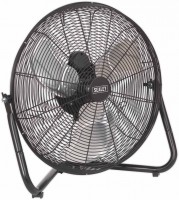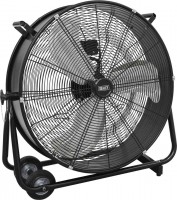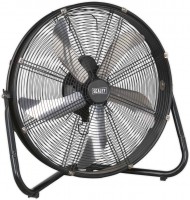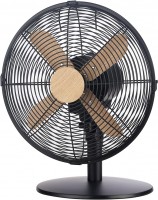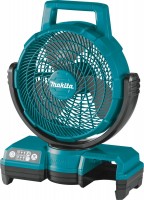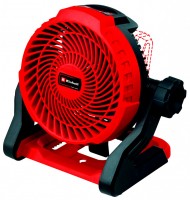Fans FARO
All Fans Advanced filters → |
You might be interested in
Fans: specifications, types
Type
— Desktop. Small models designed to be placed on a tabletop. Usually, they have low power and are designed primarily for the person directly sitting at the table. Among those, there are also portable options ( mini-fans), which are not powered by the mains and are available for use not only on the desktop.
— Floor. Fans intended for installation on the floor. There are two types. Floor fans without stand are distinguished by the large diameter of the blades and high power, and also cannot adjust the direction and always blow in one direction. Floor standing — a classic version of home ones, which also have large blades located at a height of more than a metre from the floor and can rotate around the stand, which allows you to ventilate the entire room.
— Wall mounted. Fans equipped with special brackets that allow them to be mounted on the wall. The power of such fans is comparable to floor fans, and the advantage is that their installation does not require free space on the floor, which can be critical in small areas. On the other hand, wall mounting is much more complicated than floor mounting.
— Floor/table (2 in 1). Transformer models adapted for use as a floor or table fan. The implementation of their design may be different. The vast majority o...f such fans are equipped with a stand for placement on a desktop and a stand with a base for floor installation.
— Universal 3 in 1. Universal models can transform for use as a floor, desktop or wall fan, which can be useful when used in confined spaces. The implementation of the design itself may be different, but usually, a stand for placement on a table, a wall mount and a stand with a base for floor placement are included.
— Ceiling. With the help of a special mounting, this type of fan is installed directly under the ceiling, has large blades and has high performance. It is one of the most efficient types of fan, able to provide excellent airflow, and, in winter, such a device directs warm air downwards.
— Floor. Fans intended for installation on the floor. There are two types. Floor fans without stand are distinguished by the large diameter of the blades and high power, and also cannot adjust the direction and always blow in one direction. Floor standing — a classic version of home ones, which also have large blades located at a height of more than a metre from the floor and can rotate around the stand, which allows you to ventilate the entire room.
— Wall mounted. Fans equipped with special brackets that allow them to be mounted on the wall. The power of such fans is comparable to floor fans, and the advantage is that their installation does not require free space on the floor, which can be critical in small areas. On the other hand, wall mounting is much more complicated than floor mounting.
— Floor/table (2 in 1). Transformer models adapted for use as a floor or table fan. The implementation of their design may be different. The vast majority o...f such fans are equipped with a stand for placement on a desktop and a stand with a base for floor installation.
— Universal 3 in 1. Universal models can transform for use as a floor, desktop or wall fan, which can be useful when used in confined spaces. The implementation of the design itself may be different, but usually, a stand for placement on a table, a wall mount and a stand with a base for floor placement are included.
— Ceiling. With the help of a special mounting, this type of fan is installed directly under the ceiling, has large blades and has high performance. It is one of the most efficient types of fan, able to provide excellent airflow, and, in winter, such a device directs warm air downwards.
Power source
The presence of an autonomous way to power the device. Applicable for portable mini-fans, since stationary ones are powered by 230 V mains. There are two ways to feed:
- USB port. Models designed to be installed near the PC workplace. And it's not a problem to find a USB port, both in a PC, a laptop or a power bank.
- Battery. Portable models that do not need a power supply and can be used even outdoors. The built-in battery allows them to work for a long time. Naturally, the power of such fans is small and, like any battery technology, they need to be recharged and can be discharged at the most unsuitable moment.
- USB port. Models designed to be installed near the PC workplace. And it's not a problem to find a USB port, both in a PC, a laptop or a power bank.
- Battery. Portable models that do not need a power supply and can be used even outdoors. The built-in battery allows them to work for a long time. Naturally, the power of such fans is small and, like any battery technology, they need to be recharged and can be discharged at the most unsuitable moment.
Mechanism
Axial fans are called models of classical design — equipped with blades. Such models are simpler and cheaper, but less safe and not suitable for creating an extensive ventilation system. Radial fans are a bladed wheel hidden in a protective casing. Such designs are safer, but more complex and expensive.
Relatively recently, a third type of fan was created — rotorless. Such a device looks like a ring on a stand. The ring is hollow from the inside; when the fan is running, air circulates inside, which, thanks to special slots, entrains air from outside, driving it through the ring. Unlike other types, rotorless fans create a smooth, uniform airflow without noticeable disturbances; moreover, they do not have any moving parts on the outside and are thus the safest. However, these devices are very expensive.
Relatively recently, a third type of fan was created — rotorless. Such a device looks like a ring on a stand. The ring is hollow from the inside; when the fan is running, air circulates inside, which, thanks to special slots, entrains air from outside, driving it through the ring. Unlike other types, rotorless fans create a smooth, uniform airflow without noticeable disturbances; moreover, they do not have any moving parts on the outside and are thus the safest. However, these devices are very expensive.
Power consumption
The maximum power consumed by the fan during operation. The higher the power consumption, the higher, usually, the greater the airflow rate created by the fan, and, accordingly, the higher the performance of the device. On the other hand, power usually directly affects the price, all other things being equal.
Number of speeds
The number of preset speeds at which the fan blades can rotate. The rotation speed is usually set by pressing the corresponding button (in addition, there is also a stepless adjustment, see the relevant paragraph). Most modern models with step adjustment have three preset speeds.
Air flow
The maximum performance provided by the fan — that is, the maximum amount of air that it can pass through itself in an hour.
The air flow is selected by manufacturers, taking into account the area and, accordingly, the volume of the room for which the device is designed. For efficient operation, the device must be able to pass the entire volume of processed air through itself at least once per hour. At the same time, for models with the same area of the room, different performance parameters can be claimed — accordingly, the processing speed and efficiency will differ.
Also, note that the recommended area of the room can be estimated by performance if the latter is not stated in the characteristics. For example, if the device provides 200 m³/h, this means that the volume of the room can be less than 200 m³, which, with a standard ceiling height of 2.5 m, gives an area of 200/2.5 = 80 m². And ideally, the area should be even 2-3 times smaller — that is, be about 25-40 m².
The air flow is selected by manufacturers, taking into account the area and, accordingly, the volume of the room for which the device is designed. For efficient operation, the device must be able to pass the entire volume of processed air through itself at least once per hour. At the same time, for models with the same area of the room, different performance parameters can be claimed — accordingly, the processing speed and efficiency will differ.
Also, note that the recommended area of the room can be estimated by performance if the latter is not stated in the characteristics. For example, if the device provides 200 m³/h, this means that the volume of the room can be less than 200 m³, which, with a standard ceiling height of 2.5 m, gives an area of 200/2.5 = 80 m². And ideally, the area should be even 2-3 times smaller — that is, be about 25-40 m².
Range
Range of effective reaching of the airflow from the fan blades (in metres). The higher it is, the more powerful the device in front of us.
Minimum noise level
The maximum noise level produced by the fan when running at low speed. It is good to know this value, especially in the conditions of operation of the device at night or in rooms that need silence.
Maximum noise level
The maximum noise level produced by the fan when operating at the highest speed. For comparison: a noise of 30 dB corresponds to a distinguishable whisper at a distance of 5 m, 40 dB — to human speech, and 50 dB — to the sound background in an office room. The quieter the fan runs, the more comfortable it is to use.
Functions
— Stepless adjustment. The ability to adjust the rotation speed when a slider is used instead of several buttons. In this case, you can set the speed not step by step, but over a wide range.
— Oscillation. Thanks to the oscillation, the fan can change the direction of the airflow horizontally, while remaining stationary. The direction can be set manually, and it can also change automatically when the fan constantly changes direction. Fans with small blade diameters usually do not have this capability.
— 3D rotation. Automatic rotation is assumed not only in the horizontal plane but also vertically. The implementation of this function is different: horizontal and vertical movements can be alternated, or the head of the fan can make spherical movements. Fans with 3D rotation are better at mixing air, and when used in conjunction with an air conditioner, better cooling efficiency is achieved.
— Night mode. Designed to reduce noise levels, fans in this mode reduce the speed to a minimum and periodically turn off the rotation of the blades. Note that in this mode you will have to sacrifice the power of the fan, and in hot weather, this mode may not be relevant.
— Wind imitation. This mode periodically changes the speed of rotation of the blades, sometimes turning them off a...ltogether, creating gusts of wind. Different manufacturers call this mode differently: comfort mode, breeze mode, natural, and the like, but they all serve the same purpose.
— Height adjustment. The ability to change the height of the fan manually. Provided, usually, in floor standing models.
— Tilt adjustment. The ability to change the tilt angle of the airflow vertically. In the vast majority of models, it is set manually, but some models can change it automatically. Simple and inexpensive models often lack this capability.
— Timer. A device that automatically turns off the fan after a certain time set by the user. The presence of a timer allows, for example, to turn on the fan at night and go to bed — the device will turn itself off at the right time.
— Remote control. Possibility to control the fan from a distance. Advanced fan models are equipped with remote controls that allow you not only to turn the device on and off but also to adjust the speed and set the timer value.
— Control via smartphone. Fans that support this feature can connect to your home Wi-Fi network and be controlled directly from your phone app. Also, some models can be integrated into smart home systems to perform certain scenarios. There are models in which this function completely replaces the remote control.
— Humidification. Fans with this function are a hybrid of a classic fan and a humidifier. They have a reservoir with water and a device that supplies water vapour to the fan blades, where it is carried around the room by airflow. In general, such a combination is more effective than classic humidifiers, as it provides the evenest distribution of moisture. However, fans with humidification are quite rare.
— Ionization. The presence of a built-in air ionizer. It is believed that air saturated with negatively charged oxygen ions is extremely beneficial for health. Not all fan models (even expensive ones) are equipped with an ionizer. However, it can also be purchased separately.
— Backlight. The presence of built-in lighting sources in the fan (usually LED lamps or LED strip). The backlight can be used as an additional light source or night light, and can also be used in a decorative role to improve the appearance of the fan, making it an attractive element of the interior.
— Clip mount. Such a device allows fixing the fan on the edge of the wall shelf opposite the face, which will not only create a more pleasant air flow but save space on the desktop surface (and even on the shelf where the fan is installed). In addition, such a mount is more reliable than a simple installation on a horizontal surface — overtiping a fan with a clip mount is much more difficult than a fan standing on a desktop or a shelf.
— Display. A small screen designed to display various service information. The display can show data on the operating mode, the set timer, the time until the fan is turned off, etc. The display makes fan control more convenient, but other things being equal, such devices are usually more expensive.
— Oscillation. Thanks to the oscillation, the fan can change the direction of the airflow horizontally, while remaining stationary. The direction can be set manually, and it can also change automatically when the fan constantly changes direction. Fans with small blade diameters usually do not have this capability.
— 3D rotation. Automatic rotation is assumed not only in the horizontal plane but also vertically. The implementation of this function is different: horizontal and vertical movements can be alternated, or the head of the fan can make spherical movements. Fans with 3D rotation are better at mixing air, and when used in conjunction with an air conditioner, better cooling efficiency is achieved.
— Night mode. Designed to reduce noise levels, fans in this mode reduce the speed to a minimum and periodically turn off the rotation of the blades. Note that in this mode you will have to sacrifice the power of the fan, and in hot weather, this mode may not be relevant.
— Wind imitation. This mode periodically changes the speed of rotation of the blades, sometimes turning them off a...ltogether, creating gusts of wind. Different manufacturers call this mode differently: comfort mode, breeze mode, natural, and the like, but they all serve the same purpose.
— Height adjustment. The ability to change the height of the fan manually. Provided, usually, in floor standing models.
— Tilt adjustment. The ability to change the tilt angle of the airflow vertically. In the vast majority of models, it is set manually, but some models can change it automatically. Simple and inexpensive models often lack this capability.
— Timer. A device that automatically turns off the fan after a certain time set by the user. The presence of a timer allows, for example, to turn on the fan at night and go to bed — the device will turn itself off at the right time.
— Remote control. Possibility to control the fan from a distance. Advanced fan models are equipped with remote controls that allow you not only to turn the device on and off but also to adjust the speed and set the timer value.
— Control via smartphone. Fans that support this feature can connect to your home Wi-Fi network and be controlled directly from your phone app. Also, some models can be integrated into smart home systems to perform certain scenarios. There are models in which this function completely replaces the remote control.
— Humidification. Fans with this function are a hybrid of a classic fan and a humidifier. They have a reservoir with water and a device that supplies water vapour to the fan blades, where it is carried around the room by airflow. In general, such a combination is more effective than classic humidifiers, as it provides the evenest distribution of moisture. However, fans with humidification are quite rare.
— Ionization. The presence of a built-in air ionizer. It is believed that air saturated with negatively charged oxygen ions is extremely beneficial for health. Not all fan models (even expensive ones) are equipped with an ionizer. However, it can also be purchased separately.
— Backlight. The presence of built-in lighting sources in the fan (usually LED lamps or LED strip). The backlight can be used as an additional light source or night light, and can also be used in a decorative role to improve the appearance of the fan, making it an attractive element of the interior.
— Clip mount. Such a device allows fixing the fan on the edge of the wall shelf opposite the face, which will not only create a more pleasant air flow but save space on the desktop surface (and even on the shelf where the fan is installed). In addition, such a mount is more reliable than a simple installation on a horizontal surface — overtiping a fan with a clip mount is much more difficult than a fan standing on a desktop or a shelf.
— Display. A small screen designed to display various service information. The display can show data on the operating mode, the set timer, the time until the fan is turned off, etc. The display makes fan control more convenient, but other things being equal, such devices are usually more expensive.
3D rotation
The ability to automatically rotate the fan both vertically and horizontally. These movements can be alternate or spherical. The 3D-rotation system ensures uniform air circulation around the perimeter of the serviced premises.
night mode
Quiet fan operation mode with reduced noise. It is achieved by reducing the rate of rotation of the blades and their periodic shutdown. In night mode, the fan operates almost silently, without disturbing the sleep of the household. However, due to the reduced airflow in hot weather, the cooling efficiency drops.
wind imitation
This feature simulates the natural flow of the wind. Imitation of the wind occurs by periodically changing direction and changing the airflow strength.
control via smartphone
The ability to remotely control the operation of the fan via a mobile application on a smartphone. For some models, this function replaces the use of a remote control; for others, it allows the fan to be integrated into the smart home ecosystem.
Diameter
The item refers to axial fans and gives an idea of the size of the device. The larger the size, the more airflow the fan can produce at lower RPM (and therefore less noise). It is worth noting that sometimes this indicator is indicated for the blades, and sometimes it is fully indicated for the entire grill body. However, this already gives an idea about the size and capabilities of the device.
Number of blades
With the same power and blade width, fans with numerous blades can boast of greater air mass distillation performance. However, the formation of a powerful airflow is not affected by the number of blades, but by their diameter. In addition, the operation of multi-bladed fans is usually associated with an increased level of noise.
Water tank volume
Volume of the water tank installed in the fan with humidification function. A large capacity allows you to work longer without refilling, but it affects the dimensions and weight of the device. However, uptime also affects performance. Often devices have several modes for more comfortable humidification.
Metal structure
Fans on a metal chassis are distinguished by a reliable and high-strength design. They stand steadily on different types of surfaces, have an exquisite appearance, but are heavier than their counterparts with plastic cases. Often such fans are equipped with a guard grills and blades also made of metal.
Wood decoration
Decorative wood trim of the fan housing elements. Wooden details emphasize the noble appearance of the device and are often used to style the fan antique. Also under this item are ceiling models with blades made of MDF or wood.
Base
— Cross base. The most common type of base for floor-standing fans, it provides sufficient stability while maintaining a lightweight design. Also, fans with a cross base are usually cheaper than others. Of the advantages, a collapsible design can be noted, which creates additional convenience for storage or transportation.
— Disk base. This type of base is massive, usually, such discs at the base can weigh 3-5 kg, depending on the fan model. They are made from various materials. Usually, the disk comes as a separate part of the structure, on which a decorative overlay is put on top. It is believed that such a base provides better stability than many cross bases.
— Tripod. The least common type of base, in which, apart from the aesthetic component, there is nothing else. In terms of structure, such models are too voluminous, and in terms of reliability, they are at the level of models with a disk.
— Disk base. This type of base is massive, usually, such discs at the base can weigh 3-5 kg, depending on the fan model. They are made from various materials. Usually, the disk comes as a separate part of the structure, on which a decorative overlay is put on top. It is believed that such a base provides better stability than many cross bases.
— Tripod. The least common type of base, in which, apart from the aesthetic component, there is nothing else. In terms of structure, such models are too voluminous, and in terms of reliability, they are at the level of models with a disk.
Wheels
The presence of wheels for movement in the design of the unit. The convenience of the wheels is obvious: rolling the device is much easier than carrying it by weight. This is especially true in light of the fact that the weight of a model can be quite heavy not only for girls, but even for men.


